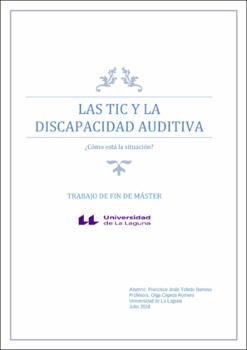Las TIC y la discapacidad auditiva: ¿Cómo está la situación?
Fecha
2021Resumen
En la actualidad educativa de todo el mundo, de nuestro país y de Canarias, debido a
los tiempos de grandes avances tecnológicos en los que nos encontramos, se está trabajando
por integrar y sacar el máximo beneficio de las tecnologías, con el fin de mejorar el
aprendizaje de los estudiantes principalmente. Si bien, del tema de la discapacidad, y en
especial de la auditiva, no se suele hablar en relación con las TIC, y por ello, con este
estudio nos propusimos conocer si realmente se hace un uso significativo de las nuevas
tecnologías para con el alumnado oyente y en especial, con el no oyente. Para ello, se
recogió información sobre una serie de variables relacionadas con las TIC y la atención a la
diversidad en la discapacidad auditiva en una muestra de 7 profesionales pertenecientes a
distintos organismos y especialidades, por un lado 3 miembros del EOEP específico de
auditivos de la Provincia de Santa Cruz de Tenerife, la orientadora y 2 docentes del CEIP
Chimisay y el audioprotesista de la Clínica Barajas, para conocer el proceso por el cual se
obtienen los recursos, se aplican y se obtienen resultados con los mismos. Tras el análisis de
los datos se concluyó con que el profesorado requiere de formación para hacer un uso
correcto de las TIC y que es necesario dar mayor visibilidad a la discapacidad auditiva. Abstract.
In the present educational world, our country and the Canary Islands, due to the
times of great technological advances in which we are, is working to integrate and make the
most of the new technologies, in order to improve student learning mainly. Although, the
issue of disability, and especially the auditory is not usually talked about in relation to ICT,
and that is why with this study we set out to know if a significant use of new technologies is
really made to the students hearing norm and in particular, with the non-hearer. To this end,
information was collected on a series of variables related to ICT and attention to diversity in
hearing impairment in a sample of 7 professionals belonging to different agencies and
specialties, 3 members of the EOEP specific hearing of the Province of Santa Cruz de
Tenerife, the counselor and 2 teachers of the CEIP Chimisay and the hearing care
professional of the Barajas Clinic, to meet the process by which resources are obtained,
apply and obtain results with them. After the analysis of the data, it was concluded that the
4
teaching staff requires training to make correct use of ICT and that it is necessary to give
greater visibility to the hearing disability





